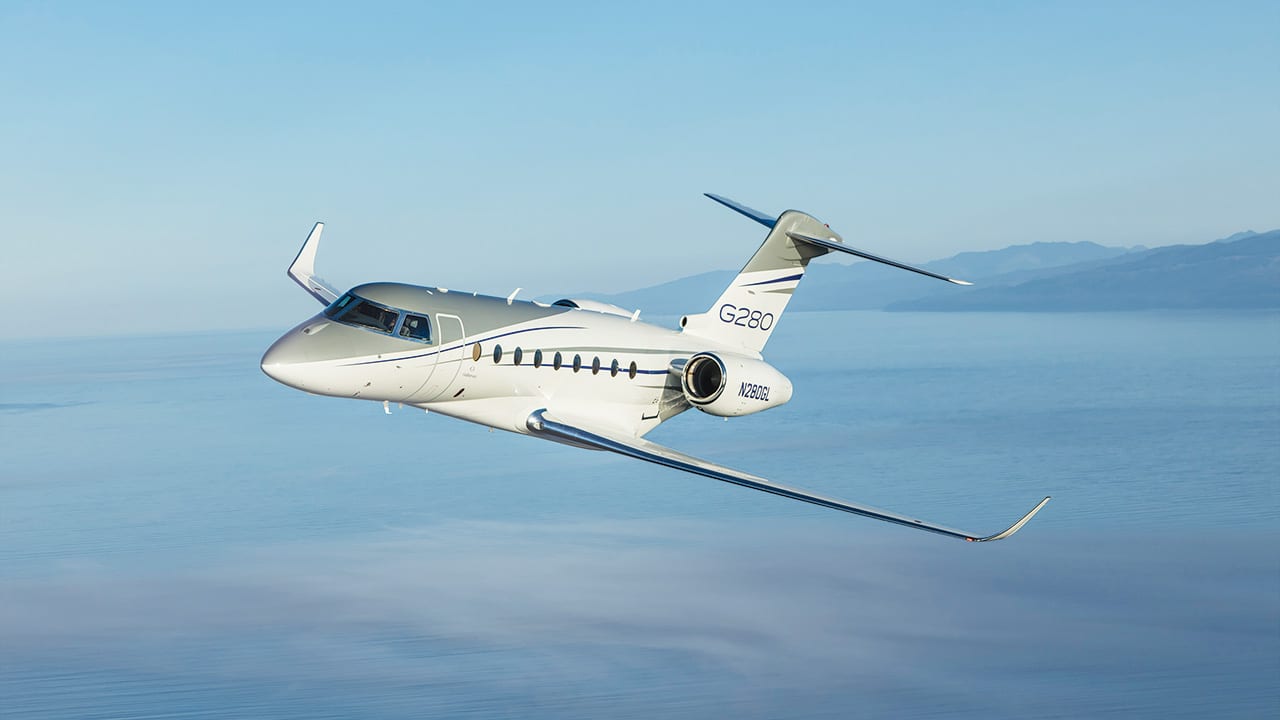
Viasat reported revenue growth for the company’s government systems and satellite services segments. Viasat said that its next-generation Ka-band IFC system was approved for Gulfstream G280 aircraft (pictured here) and received type certification for Embraer Praetor 600 aircraft.
While Viasat has run into earnings headwinds because of the grounding of the Boeing 737 MAX airliner, Viasat’s CEO on Feb. 6 predicted strong revenue growth ahead for broadband.
“In the near to mid-term aeronautical broadband, both government and commercial, has great growth potential,” Viasat CEO Mark Dankberg said in a fiscal 2020 third quarter earnings call. “We’re aiming to translate the accomplishments and market share gains we’ve achieved in North American in-flight connectivity [IFC] on a global basis, and we’re making significant progress. By the nature of how government platforms are deployed, global expansion opportunities are already in motion. Government systems is firing on all cylinders and creating more opportunities from network effects across several product lines.”
Third quarter fiscal 2020 Viasat revenues were $588 million, up from $555 million last year, and adjusted earnings before interest, taxes, depreciation and amortization (adjusted EBITDA) was $122 million, up from $109 million in 2019.
Shawn Duffy, Viasat’s chief financial officer, said that the third quarter of fiscal 2020 reflected “strong revenue growth in government systems and satellite services.” Viasat reported government systems sales increased from $250 million in the third quarter of last year to $292 million this year, as the company had “higher product sales in tactical radios, mobile broadband, tactical data links and government SATCOM products.”
Viasat recently received a $90 million Indefinite-Delivery/Indefinite-Quantity (ID/IQ) contract from United States Air Force (USAF) Life Cycle Management Center at Wright Patterson AFB, Ohio to provide USAF special forces with the company’s Battlefield Awareness Targeting System—Dismounted (BATS-D) handheld Link 16 radios, also known as AN/PRC-161 radios.
The company has said that it has provided 2,500 BATS-D radios so far to U.S. forces and that BATS-D “is the world’s first and only handheld Link 16 radio” and “bridges a critical gap between air and ground forces by providing warfighters at the tactical edge with real-time, secure, reliable access to integrated air and ground information for improved situational awareness and enhanced close air support communications.”
Viasat reported satellite services revenue of nearly $212 million for the third quarter of fiscal 2020 – a record high – and up from $178 million last year, according to the company.
Viasat said that its next-generation Ka-band IFC system was approved for Gulfstream G280 aircraft and received type certification for Embraer Praetor 600 aircraft. In addition, Viasat’s dual-band business aviation IFC system received certification for the Bombardier Global 5000/6000/GEX family, and Brazil’s Azul Airlines picked Viasat to install IFC equipment and manage services on more than 100 Airbus A320neo and Embraer E195-E2 aircraft, and EL AL Israel Airlines “committed to go full fleet with Viasat, adding Viasat’s latest equipment to its new Boeing 777 widebody and remaining Boeing 737 narrowbody fleet,” according to Viasat.
Viasat reported IFC services on 1,379 commercial in-service aircraft, excluding 90 737 MAX planes “that already have Viasat services enabled but remain grounded as of the end of the quarter,” Duffy said during the Feb. 6 earnings call.
Last May, at the end of fiscal 2019, Viasat reported a yearly doubling of the number of commercial in-service aircraft with Viasat IFC equipment installed from 635 commercial in-service aircraft to 1,312. American Airlines drove much of the increase, as the airline switched from Gogo to Viasat on some 500 planes.
 | Want to hear more on aircraft connectivity applications? Check out the Global Connected Aircraft Podcast, where Avionics editor-in-chief Woodrow Bellamy III interviews airlines and industry influencers on how they’re applying connectivity solutions. |
Viasat’s commercial networks business, which includes the installation of IFC terminals, saw a $42 million decline in revenues, from $127 million in the third quarter of fiscal 2019 to $85 million this year, “due entirely to the comparative impact of last year’s spike in the IFC terminal installations [accelerated IFC equipment installations] for American Airlines, offset with other modest commercial product increases,” Duffy said. “And despite the continued grounding of the 737 MAX, our IFC terminal deliveries picked up sequentially quarter-over-quarter as mounting interest for an at home in-flight Internet experience drives IFC demand globally.”
The commercial networks segment of Viasat reported an adjusted EBITDA loss of $31 million for the third quarter of fiscal 2020, compared to a loss of $17 million a year earlier “due to expected reductions in IFC terminal deliveries and higher research and development costs associated with the Via Sat-3 space and ground segments,” the company said.